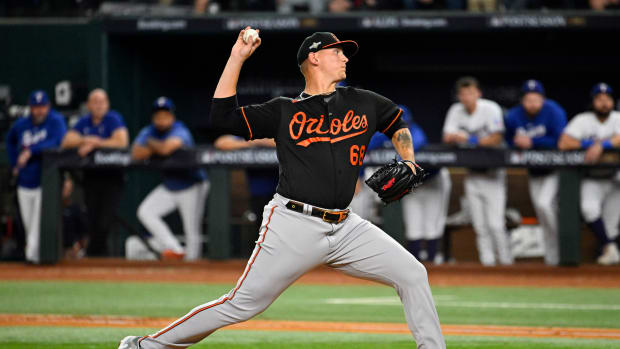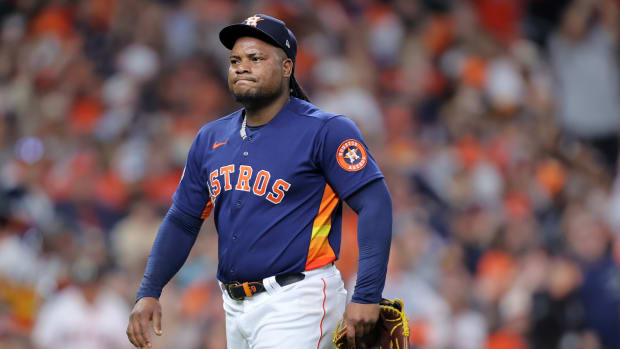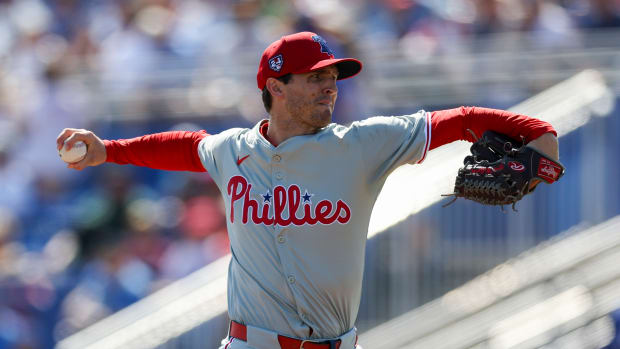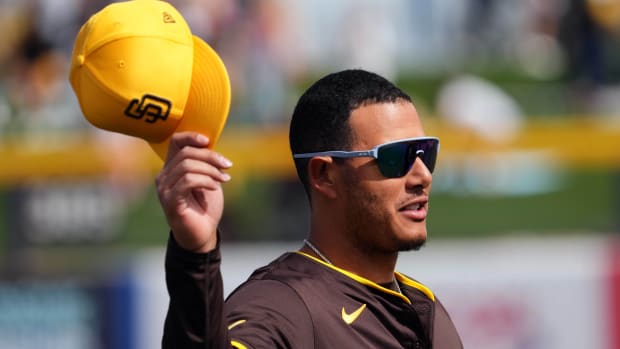Palmeiro, Tiant, Chapman headline all-time All-Cuba team
The greatest and most important impact of the United States' decision to normalize relations with Cuba after more than a half-century of the embargo will be on Cuban citizens and on the economics and development of the island itself. However, it is impossible for us to ignore the potential effect that a regulated and steady flow of talent from a baseball-mad island with a population larger than the Dominican Republic's could have on the major leagues.
JAWS and the 2015 Hall of Fame ballot: Tim Raines
Even under the embargo, which forced Cuban baseball stars who wanted to play in the majors to risk imprisonment and death to gain their freedom and achieve their dream, Cuban players have had a huge impact in the majors. In the last two years alone, White Sox first baseman Jose Abreu and Marlins ace Jose Fernandez both won Rookie of the Year awards, with Dodgers rightfielder Yasiel Puig as the runner up to Fernandez. Yoenis Cespedes, who is now a teammate of countryman Jose Iglesias in Detroit, finished second in the AL voting in 2012 and has won the last two Home Run Derbies, while Reds closer Aroldis Chapman has struck out batters at a record rate since his arrival in 2010. In the coming year, the Diamondbacks' Yasmany Tomas, the Red Sox's Rusney Castillo, and the Cubs' Jorge Soler are expected to contend for the Rookie of the Year award in their respective leagues.
There has been at least one Cuban-born player in the major leagues every year since 1911, and two prior to that (Steve Bellan in the National Association from 1871 to '73 and Chick Pedroes for two games with the Cubs in 1902). However, because of the color line in the first half of the twentieth century and the embargo in the latter half, fewer than 200 Cuban-born players have made it to the major leagues in the last century. From that group, I've compiled the following list of the greatest Cuban-born players in major league history so far.
1B: Rafael Palmeiro
JAWS and the 2015 Hall of Fame ballot: Alan Trammell
Palmeiro's career has been obscured, even marginalized, by his positive test for anabolic steroids in his final season, mere months after his finger-waving denial of steroid use before Congress. Nonetheless, he is one of just four players in major league history to collect both 3,000 hits and 500 home runs in his career (joining Hall of Famers Hank Aaron, Willie Mays, and Eddie Murray). Palmeiro hit .288/.371/.515 (132 OPS+) in his 20-year career, amassing 3,020 hits and 569 home runs, and though he only made four All-Star teams, he picked up MVP votes in ten seasons, topped 40 home runs four times, and in 1999 hit .324/.420/.630 (160 OPS+) with 47 homers and 148 RBI, all of those career highs.
Born in Havana and having defected to the U.S. with his family as a child, Palmeiro leads all Cuban-born players in Wins Above Replacement (71.6), games (2,831), plate appearances (12,046), at-bats (10,472), runs (1,663), hits, doubles (585), RBI (1,835), walks (1,353), intentional walks (172), slugging (minimum 1,000 PA), OPS (.885) and OPS+ (both minimum 1,100 PA). But because of that positive test, he may never get into the Hall of Fame, having fallen off the ballot last year after receiving less than five percent of the vote in his fourth year of eligibility.
2B: Tony Taylor
Taylor, who played 14-and-a-half of his 19 major league seasons with the Phillies, was an All-Star in 1960 and picked up some down-ballot MVP votes in 1963. But he was never much more than a steady presence in the Phillies' lineup and is probably best remembered for being the second baseman on the 1964 team that famously collapsed down the stretch. From 1959 to 1970, his age-23 to -34 seasons, he averaged just 1.6 WAR per season while playing solid defense and hitting .263/.322/.352 (89 OPS+).
Second base is a thin position among Cuban-born players, however. The only other Cubans with major league careers of any significance for whom second base was their primary position were the eccentric Tito Fuentes, the scrappy Cookie Rojas, and Chico Ruiz, who is best remembered for the steal of home that started the Phillies' September losing streak in 1964.
SS: Bert Campaneris
For Giants, success starts with Bruce Bochy, 2014 Coach of the Year
Generally speaking, the best Cuban-born players to reach the major leagues have been outfielders, pitchers, or shortstops. Campaneris, who escaped Cuba just before the Bay of Pigs invasion in April 1961 and signed with the Kansas City Athletics that same month, had the best career of that last group. A six-time All-Star who received-down ballot MVP votes in eight seasons, Campaneris was an outstanding fielder and a prolific base stealer who starred for the dynastic Oakland A's of the early 1970s. From 1968 to 1977 (which he spent with the Rangers), Campaneris averaged 4.7 WAR per season. From 1965 to 1972, he averaged 51 steals a year, leading the American League six times and the majors twice in that span; he succeeded in 79 percent of his attempts over those eight seasons. His 649 career steals rank 14th all-time and lead all Cuban-born players by 320 over his cousin Jose Cardenal, and his 86 triples tie him with Taylor for the most by a Cuban-born player. Campaneris is also remembered for being the first major leaguer to play all nine positions in a single game, doing so on Sept. 8, 1965.
3B: Tony Perez
Padres land OF Myers, but Nats may have gotten best of three-team trade
This might seem like cheating. After all, Perez, the only Cuban-born player to make the Baseball Hall of Fame for his performance in the major leagues, was exclusively a first baseman (or designated hitter) for the final 15 years of his 21-year career. However, third base is also a thin position in this list, and Perez did spend five years as the Reds' primary third baseman from 1967 to 1971, making four All-Star teams (including his only All-Star start in 1970) at the position and finishing third in the MVP voting as a third baseman in 1970. One could argue Perez's best seasons (1969 and '70, the latter in particular) came at third base. Perez was a fine fielder at the hot corner, as well, but when the Reds sent first baseman Lee May to the Astros for Joe Morgan and others after the 1971 season, Perez was moved across the diamond to fill the vacancy.
Ironically, Perez, who signed with the Reds in March 1960, may have been a more deserving Hall of Famer had he remained longer at third base, where his defensive contribution was greater and the offensive standard was lower. Nonetheless, after nine ballots, he was elected with 77.2 percent of the vote in 2000. His 2,777 hits and 379 home runs are the most among Cuban-born players never to have been associated with steroids.
C: Joe Azcue
This is the weakest position on this list. Azcue, who originally signed with the Reds in 1956, never qualified for a batting title, but he did average 338 PA per season from 1962 to 1970, most of those coming with Cleveland, with whom he made the 1968 All-Star team. A catcher in a pitching-dominated era, Azcue's batting stats don't impress on first glance, but from 1966 to 1968, he hit .269/.320/.391, which translated to a 109 OPS+; the average AL catcher in '68 hit .222/.295/.325. Azcue also threw out 45 percent of attempting base stealers in his career against a league average of 37 percent and led the majors by throwing out 62 percent (28 of 45) in 1966.
Most memorably, from 1964 until he was traded in April 1969, Azcue formed an all-Cuban battery with Luis Tiant in Cleveland, a relationship that peaked with Tiant's remarkable 1968 season, in which he led the league with a 1.60 ERA and had a 1.53 ERA when throwing to Azcue. Nonetheless, it's not difficult to imagine Havana-born Yasmani Grandal challenging Azcue for this position.
RF: Tony Oliva
JAWS and the 2015 Hall of Fame ballot: Nomar Garciaparra
Born Pedro Oliva Jr., Oliva was signed by the Twins in February 1961, two months before the Bay of Pigs, but because he lacked a passport and the time to acquire one before the start of spring training, he left his home country with his brother Antonio's papers, and thus spent his major league career as Tony. The AL Rookie of the Year in 1964, Oliva was one of the best hitters in baseball from 1964 to 1971, hitting .313/.360/.507 (140 OPS+) during those pitching-dominated years. He made the All-Star team and picked up MVP votes in all eight seasons, which included the Twins' first pennant in 1965 and additional playoff berths in '69 and '70 (the Twins lost the ALCS to the Orioles both years despite Oliva hitting .440/.462/.840 in 26 plate appearances).
However, knee problems stemming from an injury in June 1971 limited him to ten games in 1972. After that season, he never played the field again and lasted just over three more seasons as a good but not great designated hitter before his bad knees forced him to retire.
CF: Tony Gonzalez
Signed by the Reds in early 1957, Gonzalez spent most of his career as Taylor's teammate on the Phillies. An underrated player who never made an All-Star team but did pick up down-ballot MVP votes in three seasons, Gonzalez hit .299/.364/.441 (125 OPS+) from 1961 to 1967, a run capped by his .339/.396/.472 line in '67 at the age of 30. That worked out to a 147 OPS+ in a season in which the average NL centerfielder hit .269/.332/.407; even Willie Mays failed to match Gonzalez's production. Gonzalez fell off quickly from there, however. Drafted by the Padres in the expansion draft in October 1968, he finished his career in San Diego, Atlanta and Anaheim and was out of baseball soon after his 35th birthday.
LF: Minnie Miñoso
Breaking down the first-year candidates on the Hall of Fame ballot
A star third baseman in the Negro National League in his early twenties, Miñoso was signed by Cleveland owner Bill Veeck in early 1948 but didn't get a proper major league opportunity until being traded to the White Sox in April 1951. As a result, Miñoso lost something close to six seasons (three in the Negro Leagues, three in the minors) before being set loose on the major leagues. Finally unleashed in 1951, he hit .307/.397/.476 (136 OPS+) in his first ten big league seasons, two of which he spent back in Cleveland. Over that span, he led the AL in total bases once, in doubles once, in triples thrice (and the majors twice), in steals thrice, and in times hit by a pitch nine times (all but one of them also leading the majors). He made the All-Star team in seven of those ten seasons, won three Gold Gloves for his play in leftfield (an award which wasn't introduced until 1957), and picked up MVP votes in eight of those ten seasons, finishing fourth in the voting four times.
Miñoso only had one more prime season in him after that point and was out of the major leagues after 30 games in 1964, but, a favorite of Veeck's, he returned to make cameo appearances in 1976 (going 1-for-8) and 1980. The gimmicky returns aside, there are many who believe that Miñoso belongs in the Hall of Fame, myself included. Unfortunately, he fell four votes shy of induction on this year's Golden Era Committee ballot.
DH: Jose Canseco
An admitted steroid user who after his career was over would brag about being the Johnny Appleseed of steroids in baseball, Canseco nonetheless did some remarkable things on the field. The most memorable of those was his 1988 season, in which he predicted that he would and then did become the first player in major league history to steal 40 bases and hit 40 home runs in the same season. Canseco, who had previously won the AL Rookie of the Year in 1986, won the MVP award for that performance, which helped lead the A's to the first of three consecutive pennants.
Little big league: How Jose Altuve became an unlikely batting champ
From 1986 to 1992, Canseco made four All-Star teams, won three Silver Sluggers, and picked up MVP votes in five seasons, finishing fourth in 1991. From 1988 to 1996, he hit .279/.369/.540 (147 OPS+) and averaged 29 home runs per year despite frequent trips to the disabled list and Tommy John surgery in 1993 following an ill-advised attempt to pitch for the Rangers (he gave up three runs in his one inning of work). Canseco, whose family defected when he was just an infant, was born in Havana just two months before Palmeiro and was later teammates with him in Texas; his 462 career home runs rank second among Cuban-born players behind Palmeiro.
SP: Luis Tiant
Known for his big cigars, bigger personality, creative facial hair, and even more creative windup, El Tiante may be the most iconic Cuban player in major league history. The son of a Negro League pitcher with the same name but a very different build (Luis Jr. was stocky, his old man was lean), the younger Tiant pitched in the Mexican League in 1960 and '61, which kept him out of Cuba in the wake of the Bay of Pigs and allowed him to sign with Cleveland in early 1962. A swing-man with Cleveland in his mid-twenties, Tiant settled into the rotation in 1967, striking out 219 men and leading the majors with 9.2 strikeouts per nine innings, then had one of the signature seasons in the Year of the Pitcher, going 21-9 with a AL-best 1.60 ERA in 1968, making his first All-Star team and finishing fifth in the MVP voting.
JAWS and the 2015 Hall of Fame ballot: Jeff Kent
His record nearly reversed itself the following year, however, as he led the majors in home runs and walks allowed, then was traded to Minnesota that fall. With the Twins, a shoulder injury derailed his career, but he came back in a big way with the Red Sox in his thirties. Starting with a major-league best 1.91 ERA in 179 innings as a swing-man in 1972, Tiant went 121-74 with a 121 ERA+ from 1972 to 1978, making the All-Star team in '74 and '76. He won twenty or more games in those two seasons, as well as in 1973, led the majors in shutouts in '74 (his third league-leading shutout total), finished in the top six in the Cy Young voting three times, and led Boston to the pennant in '75 with complete-game wins in his first three starts that postseason, including a shutout of Perez's Reds in Game 1 of the World Series.
Tiant's was not a Hall of Fame-quality career, but it was a memorable one and left him as the all-time Cuban-born leader in WAR among pitchers (66.1), games started (484), innings pitched (3,486 1/3), wins (229), shutouts (49), and strikeouts (2,416). Honorable mention here goes to Dolfe Luque, Oliva's teammate Camilo Pascual, Mike Cuellar, and the Hernandez brothers, Orlando and Livan. Speaking of which, the Hernandezes and Tiant have been the subject of a pair of excellent documentaries about Cuban major leaguers and their relationship to their home country — respectively, Brothers in Exile and The Lost Son of Havana. Both are well worth your time.
RP: Aroldis Chapman
One could argue that Chapman is still in the process of earning this position, but I'd much rather list him here than the likes of Pedro Ramos, Diego Segui or Danys Baez, among other underwhelming options. Chapman's next save will tie him with Baez for the most by a Cuban-born pitcher (114), and while Chapman has a while to go before he leads that group in relief appearances or games finished, his dominance as a reliever is unmatched among his countrymen.
JAWS and the 2015 Hall of Fame ballot: Carlos Delgado
Chapman's 15.3 strikeouts per nine innings are the most by any major leaguer with seven or more innings pitched in his career. His 17.7 strikeout-per-nine ratio in 2014 is the highest single-season mark by anyone with more than six innings pitched in a given season (Chapman threw 54 frames this year), and in his 252 2/3 major league innings, Chapman has struck out 430 batters. That's 43.3 percent of the batters he has faced in his career, including 52.5 percent of the batters he faced in 2014. Add in what is considered the fastest pitch in major league history (105 miles per hour) and a career 169 ERA+, bettered only by Jose Fernandez (170) among Cuban-born players with 20 or more career innings pitched, and it's hard not to favor Chapman.
Manager: Fredi Gonzalez
Like Canseco and Palmeiro, Gonzalez was born in Cuba in 1964, defected to the United States with his family as a child, and grew up in Miami. Gonzalez and Canseco were both drafted by major league teams in 1982, but Gonzalez, a catcher taken by the Yankees in the 16th round, never made it above Double A as a player. By his mid-twenties, his playing career was over, but a coaching career that began at the University of Tennessee in 1990 eventually got him to the majors with the Braves in 2003.
His major league managerial career began with his hometown Marlins in 2007. After losing 91 games that season, Gonzalez's Marlins improved by 13 wins in '08 and by another three in '09, but he was gone after a slow start in '10, only to find himself named Bobby Cox's successor in Atlanta in 2011. Gonzalez has had greater success in Atlanta, but his first year was marred by a late-season collapse that saw the Braves lose a playoff spot on the final day of the season. In his second season, Atlanta lost the first-ever Wild-Card Game, and his third season, despite 96 wins, ended in an all-to-familiar first-round exit for Atlanta.
This past season, Gonzalez's seventh full season as a manager, saw the Braves completely fall apart in September and fail to win 80 games for the first time since 1990. Nonetheless, Gonzalez has a .527 career winning percentage and is by far the longest-tenured Cuban manager in major league history.
Honorable mention: Martin Dihigo
Dihigo never played in the major leagues because of the color line, but he is in the Baseball Hall of Fame as a Negro Leaguer and is widely considered not only the greatest Cuban baseball player of all-time, but also one of the greatest players in baseball history. Though we can read numerous accounts of how Dihigo, who excelled as both a pitcher and a hitter, was blessed with every imaginable tool, we'll never be able to evaluate just how good he was or how he would have performed in the majors during his prime in the 1920s and '30s. Sadly, the same could be said about countless other Cuban stars from the last half-century. With the normalization of relations between the U.S. and Cuba, however, there is hope that we will never again have to wonder what could have been for Cuba's best players.



































